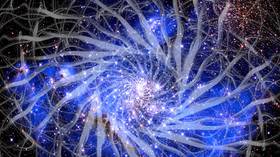Astronomers solve riddle of ‘impossible’ galaxy made of 99.99% dark matter

The Dragonfly 44 galaxy has been a thorn in the scientific community’s side ever since it was found to consist almost entirely of dark matter in 2016. New research has allowed for a collective sigh of relief, however.
The galaxy, located some 330 million light-years away in the Coma Cluster, contains 1,000 times fewer stars than the Milky Way, making it extremely dim.
Four years ago, astronomer Pieter van Dokkum of Yale University counted the number of clusters around the galaxy and, using the standard technique for determining the quantity of dark matter in an area of space, was startled by what he found.
Dragonfly 44 was apparently made up of 99.99 percent dark matter, a finding which, if confirmed, would have forced a massive overhaul of our physics, cosmological models and our entire understanding of the universe.
Also on rt.com Scientists spot MONSTER black hole with 6 entire GALAXIES trapped in its gravity wellDark matter cannot be observed directly, instead we can only observe its impacts on the universe around it, much like we can only see the wind rustling through the leaves or blowing debris about the streets.
In the case of dark matter, we can infer its presence by observing phenomena such as gravitational lensing, in which light bends around massive objects thanks to their immense gravity. The degree to which the light bends allows us to determine the mass of an object, for instance a galaxy.
Scientists then examine the galaxy and tally up all of the matter we can detect directly (on all electromagnetic wavelengths) including stars, planets, nebulae etc. This is then subtracted from the initial figure implied by the gravitational lensing, and voila, the amount of dark matter in a given area is determined.
Using this technique, the scientific community's best guess places average dark matter concentrations across the universe at around 85 percent (though this figure varies depending on galaxy type) – a good deal short of the 99.99 percent originally suspected to inhabit Dragonfly 44.
Also on rt.com ‘No earthly fireworks display can compete’: Hubble beams back unreal footage of supernova explosion 70mn light years awayA recount conducted by astronomer Teymoor Saifollahi of the Kapteyn Astronomical Institute in the Netherlands using the same Hubble Space telescope data as the initial study, but using far stricter criteria, found far less matter, and thus far less dark matter in Dragonfly 44.
“Dragonfly 44 (DF44) has been an anomaly all these years that could not be explained with the existing galaxy formation models,” said Saifollahi.
“Now we know that the previous results were wrong and that DF44 is not extraordinary. It is time to move on.”
These kinds of revisions help us refine our research into one of the most elusive, enigmatic but arguably most important aspects of our universe.
Think your friends would be interested? Share this story!















